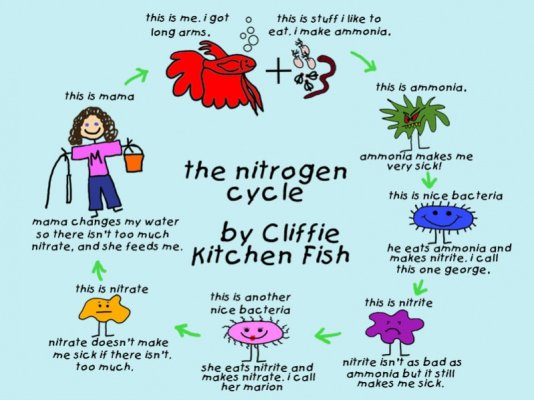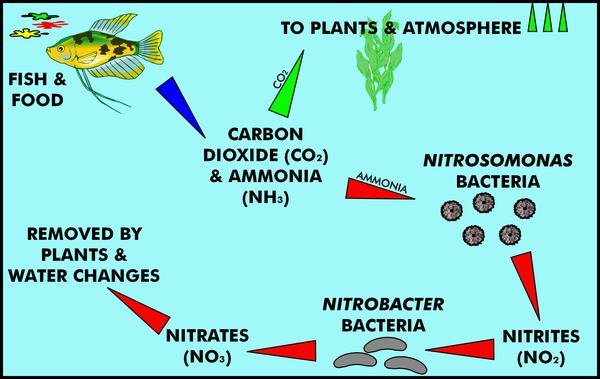Angel_fish
Aquarium Advice Activist
I feel its important to post this because all these so called "experts" dont know whats going on in there tank. I suggest you read all of it not bits and pieces.
First you buy the tank and filter and all the rest. Observe how clean and nice it is... It wont be forever. You put it all together, and get some fish and are shocked awed in how amazing everything looks until...
Step one: The Ammonia Cycle
At the moment you have bacteria that eat chemicals in the water as well as fish pee. The fish pee combined with these bact produce ammonia, which is why the aquarium ammonia levels raise up. But not for long...
Step 2: The Nitrogen Cycle:
Suddenly your scared as the ammonia is gone but nitrat and nitrie have gone up. Now there is a new kid on the block that eats Ammonia but pees nitrogen. The ammonia bacteria has already settled in the filter and gravel/sand, and these guys are going nuts floating around the water on an eating frenzy. Its like a Chinese buffet for them. Then...
Step 3: The Tank is Matured.
A third bacteria comes in that makes everything all better. These bacteria are nitrogen fixation bacteria. They eat nitrate and nitrite and turn it in to oxygen and carbon. Under a microscope the look like little pills that have a tail and swim. They also are the bact that eat excess fish food, poop, and other gunk.
MYTH 1: Bacteria come with filter media and substrate.
No they do not, the filter media is only there to provide a place for the bacteria to colonize. The charcoal in the filter bags not only puts carbon in the water but makes the filter attractive for bacteria to settle in and call home. All bacteria in the tank originate from the water added and the air.
MYTH 2: Constant water changes are needed during the cycle.
Think of the old west. Aside from train robbers and the gold rush, things in the west were pretty rural. The average town was maybe 50-300 people with nothing else around for miles... That is your fish tank in bacteria. Imagine if lincoln went in and bulldozed every town in the west because there were gunslingers everywhere... The west would never have been settled like today. California would still be nothing but back hills and mountaineers. The same goes for your fish tank, if you constantly change the water during this cycle you are not letting the new settlers to move in, which prolongs the whole cycle. Ideally you want to speed up the cycle and make it as inviting as u can for microbs.
MYTH 3: Avoiding maturing cycle.
Can you stop a hurricane? NO!!! its a cycle of nature. The same cycle occurring in your tank began on earth 4.5 billion years ago, this is the very foundation that created and supports all life on planet earth.
MYTH 4: All the fish will die during this cycle.
Some might but not all. It can help ensure none of them die if you add air stones. The gases coming in the tank have a lower mass then the ammonia and nitrogen... This means the harmful stuff gets pushed upwards in the tank and can not diffuse into the fishes gills as easily... Which if you understand any of that, understand atleast that its a good thing. Salt can also help as the salt will try to stay at the bottom of the tank and the ammonia and nitrogen will float to the top. As Ammonia and nitrogen have a lower atomic mass then salt.
MYTH 5: Stress coat helps.
Yes and no. Stress coat only nourishes the bacteria and feeds them. It dosnt add the bacteria at all it just makes it so they are healthy and reproduce faster rather then with out it.
Ideally water changes should be about 30% a week during the maturing cycle. And 10% there after. The cycle can range between a week to 3 months depending on the size of tank and how much space (filter, amount of gravel, etc..) bacteria have to populate. You can make the tank more inviting by adding that coal from the filter bag to the substrate, you can also use substrate from an already cycled tank. Even taking the filter from an older tank and rinsing it out in the new tank is ideal. Yes it will get ichky but it will clear. In nature nothing can live in clear water, actually clear water is a bad sign. Why would that be different in your living room?
The life in a fish tank is not limited to just the fish. Every square micro meter is a living breathing ecosystem. Each bacteria feeds off the other which is why the cycle comes in stages. As the ammonia bacteria populate, soon the ammonia eating bacteria follow. If you dont understand this cycle you have no business giving people advice.
Foot note:
All of the information I provided comes from going to college studying micro biology, chemistry, and biology... Im not taking advice from armatures as I have already studied it in an academic setting. Though this is severly broken down, think of it as a "for dummies" article. Though i realize this site seems loaded with false info from people who dont understand the process, and clashes with many beliefs some readers may have... I expect those people dont explore the option of checking sources... If you fail to believe any part of this. GOOOGLE.
First you buy the tank and filter and all the rest. Observe how clean and nice it is... It wont be forever. You put it all together, and get some fish and are shocked awed in how amazing everything looks until...
Step one: The Ammonia Cycle
At the moment you have bacteria that eat chemicals in the water as well as fish pee. The fish pee combined with these bact produce ammonia, which is why the aquarium ammonia levels raise up. But not for long...
Step 2: The Nitrogen Cycle:
Suddenly your scared as the ammonia is gone but nitrat and nitrie have gone up. Now there is a new kid on the block that eats Ammonia but pees nitrogen. The ammonia bacteria has already settled in the filter and gravel/sand, and these guys are going nuts floating around the water on an eating frenzy. Its like a Chinese buffet for them. Then...
Step 3: The Tank is Matured.
A third bacteria comes in that makes everything all better. These bacteria are nitrogen fixation bacteria. They eat nitrate and nitrite and turn it in to oxygen and carbon. Under a microscope the look like little pills that have a tail and swim. They also are the bact that eat excess fish food, poop, and other gunk.
MYTH 1: Bacteria come with filter media and substrate.
No they do not, the filter media is only there to provide a place for the bacteria to colonize. The charcoal in the filter bags not only puts carbon in the water but makes the filter attractive for bacteria to settle in and call home. All bacteria in the tank originate from the water added and the air.
MYTH 2: Constant water changes are needed during the cycle.
Think of the old west. Aside from train robbers and the gold rush, things in the west were pretty rural. The average town was maybe 50-300 people with nothing else around for miles... That is your fish tank in bacteria. Imagine if lincoln went in and bulldozed every town in the west because there were gunslingers everywhere... The west would never have been settled like today. California would still be nothing but back hills and mountaineers. The same goes for your fish tank, if you constantly change the water during this cycle you are not letting the new settlers to move in, which prolongs the whole cycle. Ideally you want to speed up the cycle and make it as inviting as u can for microbs.
MYTH 3: Avoiding maturing cycle.
Can you stop a hurricane? NO!!! its a cycle of nature. The same cycle occurring in your tank began on earth 4.5 billion years ago, this is the very foundation that created and supports all life on planet earth.
MYTH 4: All the fish will die during this cycle.
Some might but not all. It can help ensure none of them die if you add air stones. The gases coming in the tank have a lower mass then the ammonia and nitrogen... This means the harmful stuff gets pushed upwards in the tank and can not diffuse into the fishes gills as easily... Which if you understand any of that, understand atleast that its a good thing. Salt can also help as the salt will try to stay at the bottom of the tank and the ammonia and nitrogen will float to the top. As Ammonia and nitrogen have a lower atomic mass then salt.
MYTH 5: Stress coat helps.
Yes and no. Stress coat only nourishes the bacteria and feeds them. It dosnt add the bacteria at all it just makes it so they are healthy and reproduce faster rather then with out it.
Ideally water changes should be about 30% a week during the maturing cycle. And 10% there after. The cycle can range between a week to 3 months depending on the size of tank and how much space (filter, amount of gravel, etc..) bacteria have to populate. You can make the tank more inviting by adding that coal from the filter bag to the substrate, you can also use substrate from an already cycled tank. Even taking the filter from an older tank and rinsing it out in the new tank is ideal. Yes it will get ichky but it will clear. In nature nothing can live in clear water, actually clear water is a bad sign. Why would that be different in your living room?
The life in a fish tank is not limited to just the fish. Every square micro meter is a living breathing ecosystem. Each bacteria feeds off the other which is why the cycle comes in stages. As the ammonia bacteria populate, soon the ammonia eating bacteria follow. If you dont understand this cycle you have no business giving people advice.
Foot note:
All of the information I provided comes from going to college studying micro biology, chemistry, and biology... Im not taking advice from armatures as I have already studied it in an academic setting. Though this is severly broken down, think of it as a "for dummies" article. Though i realize this site seems loaded with false info from people who dont understand the process, and clashes with many beliefs some readers may have... I expect those people dont explore the option of checking sources... If you fail to believe any part of this. GOOOGLE.


